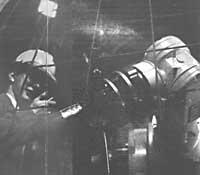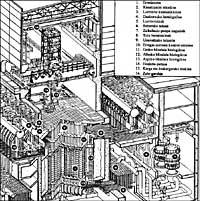How difficult it is to finish!
1987/08/01 Barandiaran, Mariaje | Irazabalbeitia, Inaki - kimikaria eta zientzia-dibulgatzaileaElhuyar Fundazioa Iturria: Elhuyar aldizkaria

Scientists and engineers, if they fulfill their program, will have to face many problems in the next three years. Two years have already been delayed. By 1996, the land currently occupied by the reactor could again be meadow. But they follow unanswered questions. For example, what will happen to the low and medium magnitude reactive waste that is left after disassembly?
Finding a place for waste will not be an easy task.
The project, which is already five years old, is neither academic. In the next 20 years, hundreds of nuclear plants will be closed worldwide. No one has completely cleaned up the nuclear plant. The experience to date has been limited to small experimental receptors. Although the Windscal reactor was built as a prototype, it has been a nuclear power generation plant. From 1963 to 1981 he has been supplying Britain's electric grid.
Dismantling is a serious problem
In most industries, the disassembly of plants and equipment is simple and economical. However, the high levels of radioactivity in ancient reactors make dismantling complicated and expensive. Nuclear plants cannot be abandoned or destroyed with picota. The design of nuclear plants does not at all facilitate the destruction of plants. The current fortresses, eleven kilometers of steel and thousands of tons of concrete, are solid structures.
People who carry out the destruction and disassembly must face the type of contaminated and activated material that is considered radioactive. The contaminated parts are the pipe, the complete equipment of the pressure pile of the reactor and the four heat exchangers. The degree of pollution depends on the nature of the exposed material and the fuel discharge produced. High-pressure water blasting and chemical decontaminants can partially remove surface contamination, but only a part of the material can be recycled or stored in a conventional manner.
The other source of radiation that the dismantlers will find is in the activated products. When the nuclear fuel is fised – breakage – the neutrons escape. These bombard the neighboring atoms. As a result, some trace elements present in steel and concrete that house the reactor area become radioactive. The parts activated by the neutrons with this system are the pressure pile of the reactor, the internal components of the vessel and its structure and the concrete shield that surrounds it.

It is difficult to estimate the radioactivity of the activated products. The organization of the components of the reactor area is very complex and it is difficult to predict the movement of neutrons. Only remote controlled equipment can dematize this aspect.
Work in three steps
According to engineers, the dismantling of a nuclear plant is a three-step process. The first step is to turn off the plant and extract the fuel.
The second requires a small destruction. Houses and buildings located outside the concrete shield that protects the reactor area must be destroyed or conditioned for another use. Few residues generated in this stage will be radioactive.
The third step, the final phase, is the one that generates most of the radioactive waste. In this area near the reactor area, radioactive isotopes are immersed in the core of the materials. The measures to be adopted (operation and remote control) make this phase of disassembly very expensive.
Windscale engineers are about to reach the third round. The turbine room is clean. Currently the work is being done within the sphere. Engineers and scientists want to build a waste packaging building to channel the active waste they are going to remove from the reactor. In the following two years, the cleaning of the hat area of the pile, which covers the fuel cylinders, will be carried out.
To do this, a giant fuel loading and unloading machine must be disassembled. Once the feeding tubes placed under the reinforced concrete shield have been cut, a robot will cut the area into pieces. This operation discovers the top of the pressure vessel. Here the work begins. A controlled machine, hung from the pile hat, disassembles the reactor area. It will work down. Cut the pressure container and its contents and take it outside.
If the engineers who are dismantling Windscale have not yet reached the third step, it is because the previous steps have created technical problems. The large amounts of asbestos present in the reactor (especially in the heat exchanger) and in the turbine room have slowed down the work. In addition, heat exchangers have been very problematic. These cessions have been contaminated with 137.
At the time of starting to work with heat exchangers, it was wanted to cut into pieces. But the idea was rejected because workers could be exposed to high doses of radiation. The second proposal suggested that the heat exchanger be collected in a dam, stored in it, and finally thrown into the sea. The delay enacted in 1983 on the discharge of radioactive waste to the sea nullified this claim. The current plan consists of decontamination of heat exchangers with nitric acid or hydrochloric acid for further cutting into parts. The way to do this will be analyzed in the next two years.
Two heat exchangers hinder the protected road that will connect the room and the reactor to use to pack the activated material. The dismantlers must lift 13 meters the heat exchangers to release the track. The packing room is formed by a mesh of concrete rooms. It has loading docks and transfer stations. A 60-ton pulp crane will move concrete blocks that will house seams.
What to do with garbage
The Windscal reactor will generate 1900 tons of activated material: Steel will be slightly less than half of the total mass, but it will have 97% of radioactivity. In addition, inside the stainless steel, with 5%, will have a 75% radioactivity.
According to the International Atomic Energy Agency, for 2010 it will be necessary to dismantle the equivalent of 200 reactors of 1000 MW.
This year the 72 MW water cooled and pressured reactor from the Shippingport plant in the US is being dismantled (see "Elhuyar. Science and Technology" Nº 1: "When the life of the center ends"). In the US. They have no intention of breaking the reactor. The ten-metre high reactor will dive into the concrete, taking the resulting block and starting a long journey (descent of the Ohio and Mississippi rivers, passage of the Gulf of Mexico and the Panama Canal and going up to the Pacific coast of the US). From the reactor.

At first the nuclear industry was proposed to pour waste into the sea. This has been impossible thanks to the international moratorium. In addition, the moratorium can be a total short-term ban. Another possibility of storage is the underground deposit. However, it is difficult to find around you a town that wants to be a landfill of radioactive waste. One of the few solutions currently existing, not adequate, is the storage of the nuclear plant. The nuclear industry does not want to know anything about it.
If the construction of a nuclear power plant costs a lot, more than dismantling. The dismantling of the Windscal power plant will cost £45 million to the British Nuclear Energy Agency.

Gai honi buruzko eduki gehiago
Elhuyarrek garatutako teknologia





